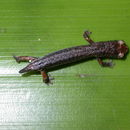fr
noms dans le fil d’Ariane


Ixalotriton parva, the dwarf false brook salamander, is a species of salamander in the family Plethodontidae. It is endemic to a small mountainous area of Mexico where its natural habitat is subtropical or tropical moist montane forests. It is threatened by habitat loss. There is some doubt whether this species should be classified as Pseudoeurycea parva or Ixalotriton parva.[1]
The dwarf false brook salamander is small with a broad head, small nostrils, protruding eyes and slender body. It grows to a length of about 7.5 centimetres (3.0 in), half of which is the tail. It is a greyish-brown colour with a pale brown stripe running along the ridge of the back and a few whitish spots on the tail, which is prehensile.[1] In appearance it is very similar to Pseudoeurycea praecellens.[2]
The dwarf false brook salamander is endemic to the Cerro Baul Mountains in the eastern part of Oaxaca State, Mexico at an altitude of about 1,600 metres (5,200 ft) above sea level.[3] It lives in virgin cloud forests and does not flourish after forestry operations have caused disturbance. It is a terrestrial species and is usually found in the water that collects in the centre of bromeliads.[3]
The dwarf false brook salamander has been little studied but the female is believed to lay several eggs in a concealed site at the beginning of the dry season. She then guards the eggs until they hatch into juvenile salamanders at the start of the rainy season, bypassing the aqueous larval stage.[1]
The dwarf false brook salamander is considered "Critically Endangered" in the IUCN Red List of Threatened Species.[3] This is because its range is only about 10 square kilometres (3.9 sq mi) and the forest where it lives is being disturbed by logging. It was last surveyed in 2007 and on that occasion, a single specimen was found.[3]
Ixalotriton parva, the dwarf false brook salamander, is a species of salamander in the family Plethodontidae. It is endemic to a small mountainous area of Mexico where its natural habitat is subtropical or tropical moist montane forests. It is threatened by habitat loss. There is some doubt whether this species should be classified as Pseudoeurycea parva or Ixalotriton parva.
El tlaconete enano Ixalotriton parvus, en inglés "dwarf false brook salamander", es un anfibio caudado de la familia Plethodontidae. Es una especie endémica de Oaxaca y Chiapas en México.
Es una salamandra de la familia Plethodontidae del orden Caudata. Es de talla pequeña, alcanza una longitud de 4 cm. La longitud de su cola es casi igual a la longitud del cuerpo y las extremidades son relativamente pequeñas. Su dorso es de gris a café oscuro, teniendo algunas veces una banda dorsal de color café o crema. La cola tiene algunas manchas o puntos de color liquen.
Endémica de México, se conoce solo para el sureste de Oaxaca y suroeste de Chiapas para el Cerro Baúl.[1]
Vive dentro de bromelias en bosque mesófilo de montaña entre 1,500 y 1,900 m.s.n.m. 1,2
Se considera como Amenazada (Norma Oficial Mexicana 059) y en Peligro Crítico en la Lista Roja de la UICN.
El tlaconete enano Ixalotriton parvus, en inglés "dwarf false brook salamander", es un anfibio caudado de la familia Plethodontidae. Es una especie endémica de Oaxaca y Chiapas en México.
Pseudoeurycea parva Pseudoeurycea generoko animalia da. Anfibioen barruko Plethodontidae familian sailkatuta dago, Caudata ordenan.
Pseudoeurycea parva Pseudoeurycea generoko animalia da. Anfibioen barruko Plethodontidae familian sailkatuta dago, Caudata ordenan.
Ixalotriton parvus est une espèce d'urodèles de la famille des Plethodontidae[1].
Cette espèce est endémique de l'État d'Oaxaca au Mexique. Elle se rencontre au-dessus de 1 600 m d'altitude sur le Cerro Baúl[1].
Le nom de cette espèce, parvus, vient du latin parvus qui signifie « petit » en référence à sa taille[2].
Ixalotriton parvus est une espèce d'urodèles de la famille des Plethodontidae.
Pseudoeurycea parva é uma espécie de salamandra da família Plethodontidae.
É endémica do México.
Os seus habitats naturais são: regiões subtropicais ou tropicais húmidas de alta altitude.[1]
Está ameaçada por perda de habitat.[1]
Pseudoeurycea parva é uma espécie de salamandra da família Plethodontidae.
É endémica do México.
Os seus habitats naturais são: regiões subtropicais ou tropicais húmidas de alta altitude.
Está ameaçada por perda de habitat.
Ixalotriton parva là một loài kỳ giông trong họ Plethodontidae. Nó là loài đặc hữu của México.
Môi trường sống tự nhiên của chúng là các khu rừng vùng núi ẩm nhiệt đới hoặc cận nhiệt đới. Nó bị đe dọa do mất môi trường sống.
Ixalotriton parva là một loài kỳ giông trong họ Plethodontidae. Nó là loài đặc hữu của México.
Môi trường sống tự nhiên của chúng là các khu rừng vùng núi ẩm nhiệt đới hoặc cận nhiệt đới. Nó bị đe dọa do mất môi trường sống.